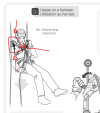Well I asked why Grigri but not Safeguard. Both are assisted though the one is not auto-locking only due to liability clause while the other can actually drop you.
The basic function of Safeguard and ID/Megawatt is the same, cam that grabs the rope. Actual difference is in that ID/Megawatt cam is shrouded deeper to prevent obstruction in normal use. The more important difference and reason why Madrock does not tell you it's auto-locking is because Safeguard is exclusively bought by yahoos who intend to abuse it and are not professionals or at least do not adhere to standardised practices in use.
Using ID/Megawatt over Safeguard won't make you any safer while hunting. Tying off brake strand of Grigri is not one tiny bit safer than Safeguard. In fact if you tie off the Grigri, it's one of the weakest belay devices on the market, the cam blows off below 10kN.
And finally let's look at Petzl documentation demonstrating appropriate use of I'D. If you're working on ID or similar device, you're expected to be backed up by separate redundant, shock absorber equipped fall arrest system. I have yet to see anyone use one in context of saddlehunting. While wearing appropriate harness for PPE use obviously.
View attachment 92600




